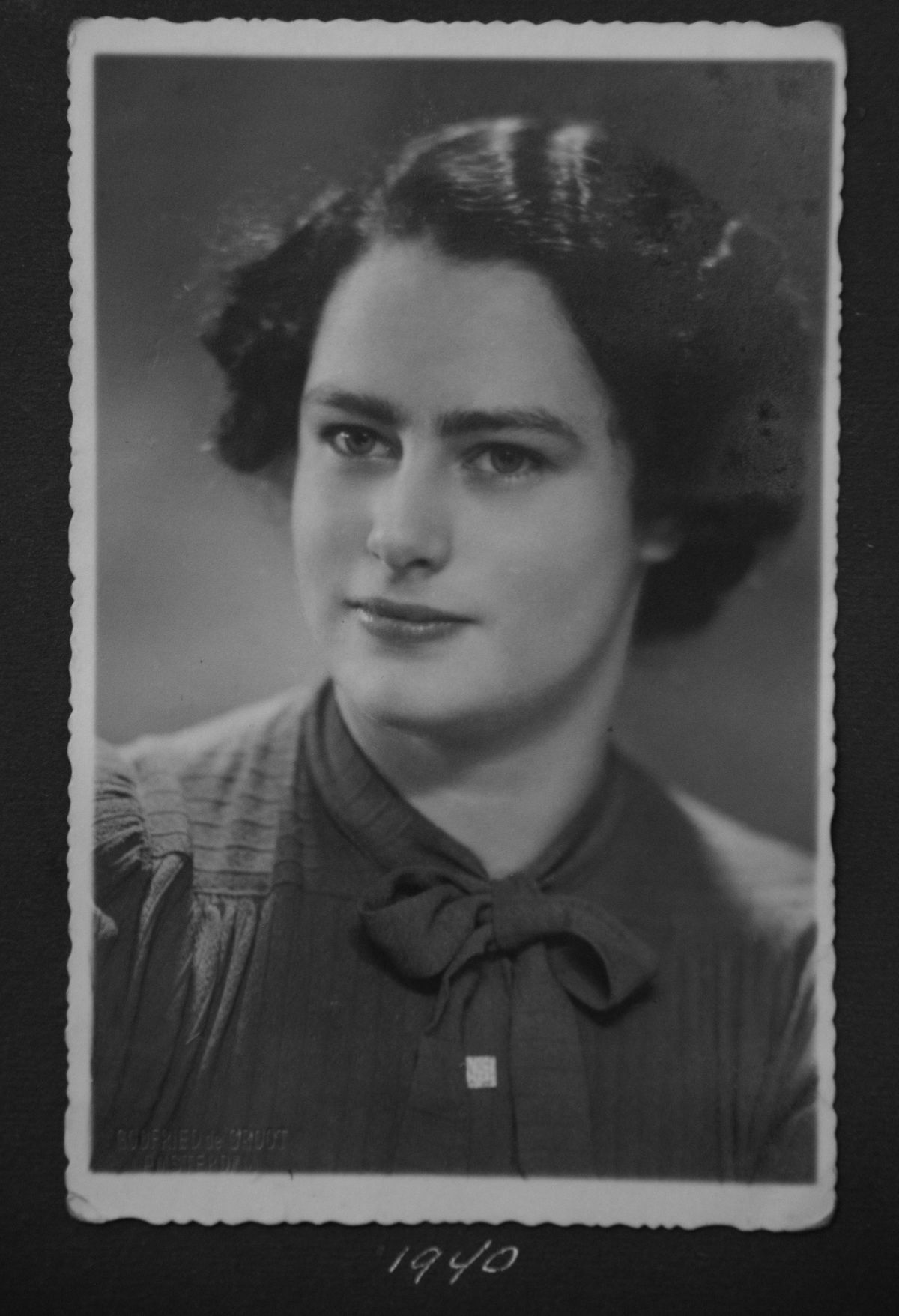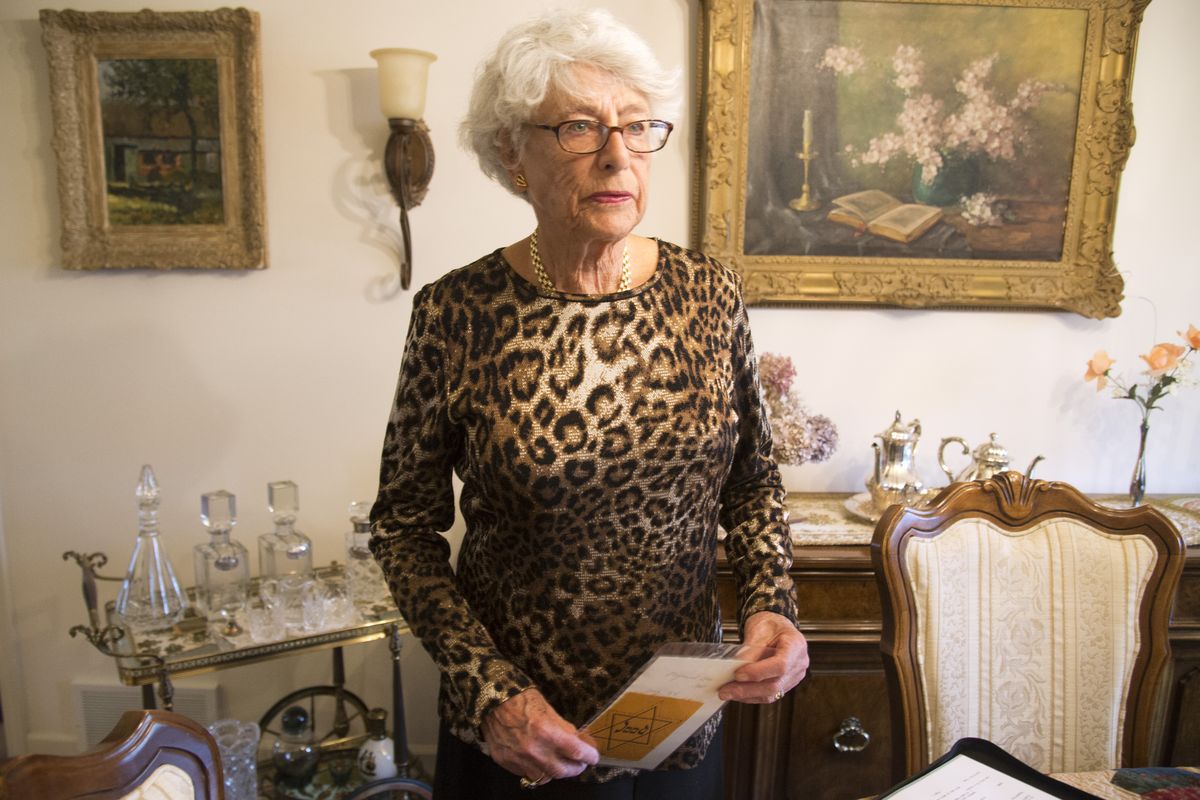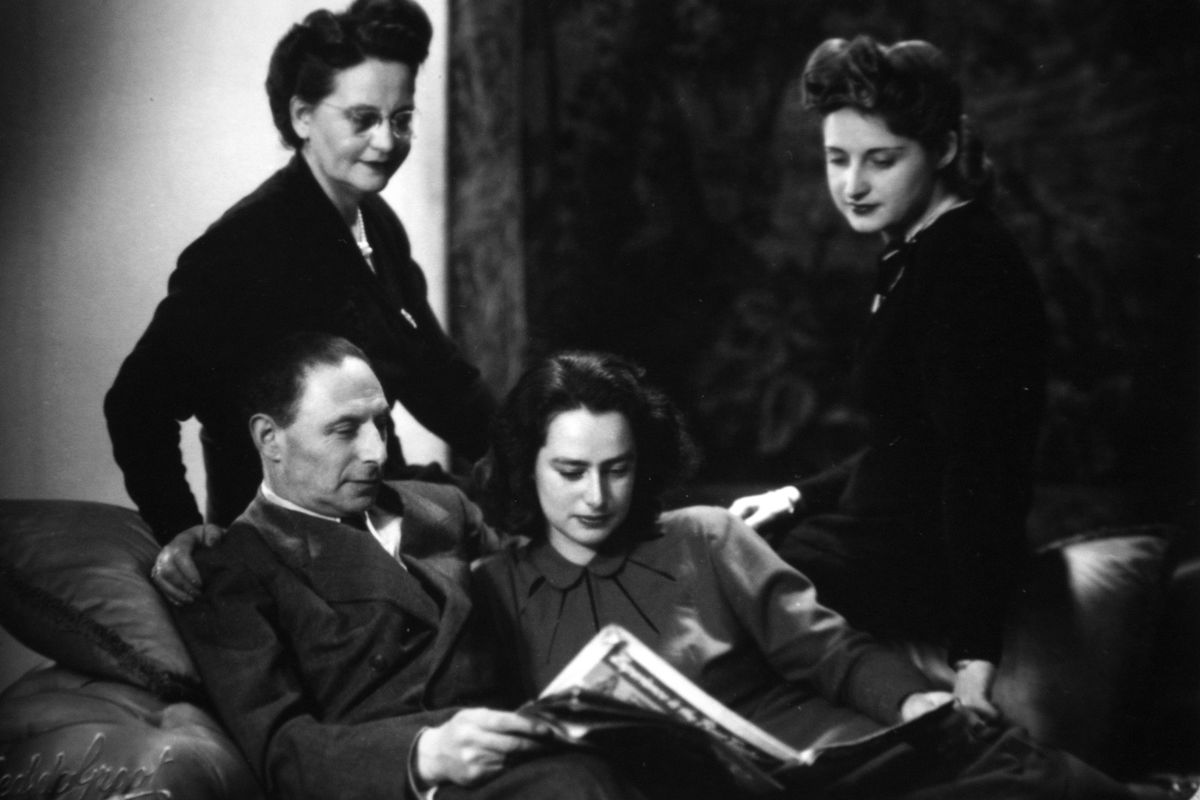Freedom fighter: Spokane’s Carla Peperzak protected fellow Jews through Dutch Resistance during World War II
Carla Peperzak, 91, holds a yellow cloth star Holland’s Jews were forced to wear under Nazi rule during World War II. Jews were required to buy the stars – at about 15 cents, the cost of two loaves of bread – and stitch them on their coats under threat of arrest. (Jesse Tinsley)Buy a print of this photo
Carla Olman Peperzak donned a blue-and-white nurse’s uniform and made her way to Amsterdam’s Central Station.
She had received word that an aunt and five cousins would be passing through on the way to Westerbork, the Nazi detention center in northeast Holland. Her uncle had already been seized by the Nazis. So when Peperzak found her relatives in a railcar waiting on the tracks she asked if she could take the youngest one.
She carried the toddler off the train. But the station was teeming with German soldiers, and a couple of them stopped her. Who are you and where are you going, they wanted to know.
Peperzak was a teenage wartime Dutch Resistance operative who, by her estimation, helped hide approximately 40 Jews from the Germans during World War II. She forged identification papers for about five dozen others, served as a messenger for the Underground movement and helped publish a newsletter of Allied Forces’ activities on a banned mimeograph machine.
These are not the things she told the Nazis.
In German, which she had learned in school as well as from her Austrian nanny, Peperzak said the boy was sick and needed to get to a hospital. She was young, attractive and Jewish. She was also disguised as a German nurse, with a stolen medical identification card in her pocket. If her true identity had been discovered, “That would have been the end of me.”
Still, she didn’t consider herself particularly brave. Her resistance was born of gratitude. Peperzak didn’t wear a star. So she helped those who did.
“I was 18, 19, 20. I was not married. I did not have any responsibility – only for myself – and that made a big difference,” she said. “I felt I could help. I had the opportunity.”
The Nazis invaded Holland when Peperzak, now 91 and a great-grandmother, was preparing to graduate from high school. She was 16 in spring 1940 when the occupation started and life began getting more difficult for Jews.
“You were always scared,” Peperzak said. “You were so careful about what you said. If you saw a German soldier you walked around the block.”
Holland had one of the highest Jewish death rates of Western Europe in World War II. Roughly a quarter – about 35,000 of approximately 140,000 Jews – survived.
Tuesday marks the 70th anniversary of the liberation of the Auschwitz-Birkenau Nazi death camp in Poland, where at least eight members of Peperzak’s family were among the 1.1 million prisoners. Most – including Peperzak’s relatives – perished. In all, some 6 million Jews were exterminated by the Nazis throughout World War II.
During the war and even for months afterward, “You never knew who was gone or who was in hiding,” Peperzak said.
Before the occupation, her close-knit, well-off family vacationed along the Dutch coast, and Peperzak dreamed of becoming a doctor. She enjoyed school – “I was always glad that vacation was over” – and considered herself “sports-minded.” She played field hockey, skated on Amsterdam’s frozen canals and sailed on the Amstel River. She was also part of a mostly Jewish rowing club. Nazis raided it, rounding up half-dozen athletes.
Peperzak grew up a block from the Frank family – Anne, Margot, Otto, Edith – near the Merwedeplein, a grassy square now anchored by a statue of the famous diarist. In an old family photo, the Franks’ apartment building stands in the background.
The families attended the same Reform temple. They also had nearby businesses. Peperzak’s father owned a clothing and fur factory a couple of blocks from the building Otto Frank at one point owned and where his family later hid.
Peperzak was nearly 6 years older than Anne Frank, author of “Diary of a Young Girl,” which describes her family’s time in hiding. She wasn’t much older than Anne’s sister Margot, and both were in the same Hebrew class at their rabbi’s home.
“I knew the (Frank) family a little,” Peperzak said. “I visited their house once. I lived very close by.”
She doesn’t remember the last time she saw them.
In early 1941, German authorities required Jews in Holland to register. There were 159,806 in all, including 19,561 born of mixed marriages, like Peperzak. Her father was Jewish. Her mother was a Catholic orphan raised by a Jewish family. Peperzak registered, receiving an identification card branded with a “J.”
In spring 1942, the Nazis upped their restrictions, requiring Jews to wear the six-pointed Star of David. Peperzak remembers sewing one onto a coat. She doesn’t remember ever wearing it.
Her father visited a lawyer, procuring paperwork identifying Peperzak, her sister and mother as non-Jewish. He still had to wear a star. He was rounded up once, missing for three days. He never talked about it.
“The less you knew, the better off you were,” Peperzak said. To protect family members, “you didn’t say anything.”
She has a hunch, though: “I have a feeling he gave them money. You could do a lot of things with money and diamonds.”
By then, Peperzak was enrolled in a private medical technologist program. She did a practicum in a local hospital, where she stole the German ID and bought the German nurse’s uniform from another worker. She also became active in the Resistance.
“I missed so many classes,” she said – and failed a few exams. “I had no time to study.”
Peperzak was 18 when she first helped a family – her uncle, his wife and their two children – go into hiding. With the aid of a trusted neighbor, Peperzak secured a place at a farmhouse in the Dutch countryside.
Through the Underground, she started securing spots for other Jews in attics, basements, crawl spaces and barns, mostly in rural Holland. During their time in hiding, she checked on her charges, bringing food, medical supplies and stolen ration cards. She often traveled by bicycle, sometimes pedaling a couple of hours each way. For longer distances, she took the train.
During her expeditions, Peperzak often donned the nurse’s uniform to lessen her chances of being caught. Still, German soldiers stopped her at least three times while she was pretending to be one of their own. Once, she was riding her bicycle in the countryside, carrying a thumbprint-making machine as well as a pile of fake identification papers. Another time, she was pedaling back from The Hague near or just past curfew. The first time was in her attempt to rescue her 2-year-old cousin from the train bound for Westerbork.
Fewer than 5 percent – about 5,200 of 107,000 people, mostly Dutch Jews – that were held at the detention center survived the war. Most were gassed upon arrival at concentration camps throughout Europe.
“We knew it was bad,” Peperzak said, “but we didn’t know how bad.”
Along with the German ID and nurse’s uniform, she had her youth, looks and resourcefulness. Each time she was stopped, she said, “I got myself out of it by flirting and by talking. I was very fortunate to be that age. I’m sure if I had been 30 I wouldn’t have gotten away with it.”
Many in the Resistance with whom she worked were young.
“You’re physically fitter. You’re willing to take higher risks. There’s a higher likelihood that you don’t have a family depending on you,” said Raymond Sun, 54, associate professor and chairman of the history department at Washington State University in Pullman. He specializes in Holocaust and genocide studies, modern German and military history, and the social history of religion.
“The values of Nazism were to crush any spark of individuality or free will,” Sun said. “Women were able to go under the Nazi radar because Nazis did not take them seriously or treated them as sex objects. A woman could use her sexuality to distract or win the trust of German officers, or masquerade as mothers. Oddly enough, because of their inferior status in the Nazi mindset, they had a greater capacity to act. To be young and female was actually a big advantage.”
Peperzak didn’t tell her parents or sister about her Resistance work.
“We just didn’t talk about it,” she said. “For 50 years, I never talked about it. I never wanted to think about it. I wanted to get away from what happened. I wanted to get away from Judaism. I really wanted to get away from it all.”
Peperzak left Amsterdam in early 1948 after marrying a Dutch Catholic in late 1947, the same year Anne Frank’s diary was published. The Peperzaks moved every few years for his studies or work as an executive with the United Nations Food and Agricultural Organization and World Bank. Their four children were raised Catholic and grew up around the world – from Liberia and Kenya to Thailand, Italy, Iowa, Alabama, California, Colorado, Washington, D.C., and Hawaii, where the couple became U.S. citizens in 1958.
Peperzak moved to Spokane in 2004, three years after her husband, Paul, died. She’s a member of the local Reform congregation, Emanu-El, as well as Temple Beth Shalom, where she helps organize an annual Holocaust commemoration.
She doesn’t know what became of the nurse’s uniform, but she believes every soul she helped hide survived. Her war experiences are never forgotten.
“It’s always somewhere in the background,” she said. “I think my whole life is influenced by what happened in the war.”
Peperzak estimates 75 percent of her relatives perished at the hands of the Nazis, about 18 people in all, including three of her father’s six siblings and the aunt and cousins from the train. But her parents helped support Loetje, the toddler she rescued, for much of his life.
Peperzak didn’t learn of the Franks’ fate until after the war. Edith Frank died weeks before Auschwitz was liberated. Anne and Margot died of typhus weeks before Bergen-Belsen, in Germany, was liberated. Only Otto Frank survived, overseeing the diary’s publication, its adaptation to film and the stage, and the founding of the Anne Frank House museum in the secret annex.
Peperzak toured it with her children and grandchildren in 1992, the same year she broke her silence. Shortly before the trip, her granddaughter Megan, now 35, asked her to speak at her school, All Saints Catholic in Spokane.
“She was shaking when she started talking,” said Peperzak’s daughter and Megan’s mom, Marian Cummings, 63. “It was a surprise when she agreed.”
Growing up, the topic was “taboo.” Recalling the war gave her mother nightmares.
Now Peperzak speaks publicly about half-dozen times a year. Her talks often end in tears.
“It’s become my mother’s mission to share her story because there are so few left,” Cummings said. “The children of today will be the last generation to meet somebody who is a Holocaust survivor.”




